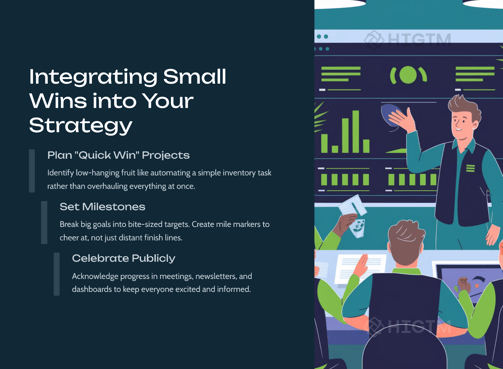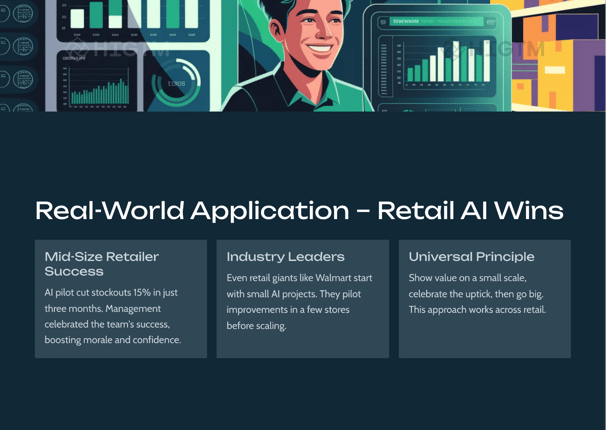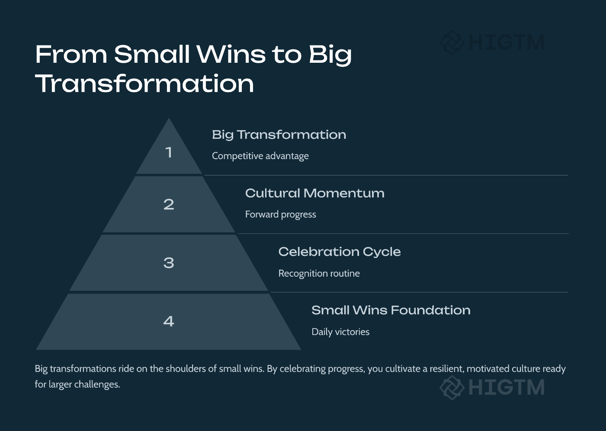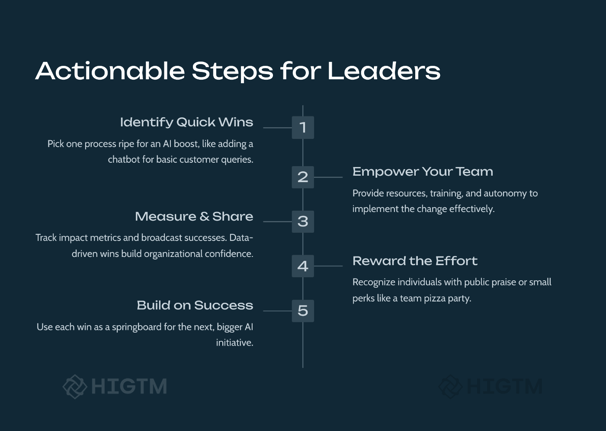80. Small Wins, Big Momentum: How Retail Leaders Boost Morale and Accelerate AI Adoption
Change in the retail industry often feels like trying to turn a giant ship – slow and challenging. But what if there were a way to build momentum faster, keep your crew motivated, and ensure your transformation stays on course? Enter the strategy of celebrating small wins. For mid-sized retail firms embracing AI-driven efficiency improvements, recognizing little victories is more than a morale booster – it’s a strategic tool. In this article, we explore why small wins matter for AI adoption in retail, how they impact your company’s culture and bottom line, and how you can systematically harness them. The approach is simple yet profound: by breaking big goals into bite-sized chunks and applauding each achievement, you create an upward spiral of positivity, engagement, and progress. Let’s dive into the psychology behind this and outline a roadmap for retail executives to turn modest victories into major success.
Q1: FOUNDATIONS OF AI IN SME MANAGEMENT - CHAPTER 3 (DAYS 60–90): LAYING OPERATIONAL FOUNDATIONS
Gary Stoyanov PhD
3/21/202513 min read

1. Why Small Wins Matter in Retail AI Transformation
1.1 They Ignite Employee Motivation and Confidence
Massive overhauls – like implementing AI across a retail operation – can overwhelm employees. But small wins spark motivation in a very human way. Harvard research on the Progress Principle found that making even minor progress on meaningful work is the top factor boosting people’s emotions and engagement at work.
These micro-achievements create a sense of forward momentum. Psychologically, when an employee or team sees a concrete positive result from an AI initiative, it builds confidence: “This new tool actually works – and I contributed!” Recognizing those contributions reinforces each person’s value. Over time, a series of small wins combats change fatigue and replaces it with an eagerness to see what the next win will bring.
1.2 They Boost Morale and Reduce Resistance
Celebrating small wins isn’t merely a pat on the back – it has a direct impact on morale. Think of each win as a dose of optimism injected into your organization. John Kotter’s renowned change management model highlights generating short-term wins as a key step specifically because “nothing motivates more than success”.
Early victories show skeptics that the effort is worth it. For example, if a pilot AI system in a store cuts checkout time by 10%, employees feel the improvement in their daily work. By publicly acknowledging this win, leadership sends a clear message: the team’s effort matters and the change is positive. This recognition helps win over doubters and reduces fear of the unknown. Over time, consistent celebration turns even cautious employees into supporters, because they see proof that changes lead to improvements for them and the customers they serve. As one tech consulting insight put it, “Recognize and celebrate small wins… This helps maintain morale and motivation during the transition.”
When morale is up, resistance goes down.
1.3 They Create a Momentum Loop
Momentum in business transformations is priceless – and small wins are the fuel that builds it. Rather than waiting 18 months to see if a large project delivers, a culture of small wins produces continuous evidence of progress. Each success, no matter how modest, becomes a building block that enables the next. It’s like a series of dominoes: one falls, and the rest start toppling in the right direction. Prosci’s research on Kotter’s model notes that short-term wins provide tangible evidence a change is moving in the right direction and help “maintain momentum and engagement throughout the change process”.
In a retail context, imagine your first win is implementing an AI chatbot that handles 30% of customer inquiries – easing the load on service staff. That win generates excitement and perhaps additional budget for phase two, say an AI tool for inventory management, which then yields another win. With each achievement, stakeholders gain confidence to support more ambitious initiatives. Success breeds success; momentum keeps building. Teams start anticipating victories, which becomes a self-fulfilling prophecy as their proactive efforts lead to further wins. In essence, small wins create a flywheel effect – once it’s spinning, it drives forward with its own energy.
1.4 They Foster a Culture of Innovation and Trust
When leaders make a habit of celebrating small wins, they cultivate a certain culture – one that values continuous improvement and encourages innovation. Why? First, frequent recognition signals to employees that trying new things is safe, even if every experiment doesn’t yield a blockbuster result. By highlighting incremental improvements, you reinforce the idea that progress is more important than perfection.
This helps create psychological safety, an essential ingredient for innovation. Teams that know their efforts will be appreciated – even if the gains are small – are more likely to take initiative and brainstorm new ideas without fear. Second, celebrating team wins builds trust. It shows leadership is paying attention to ground-level efforts and giving credit where it’s due. As tech consultancy InfoBeans observes, demonstrating early wins helps “build trust in AI by showing its ability to enhance rather than replace human roles,” thereby reducing employee apprehension.
In a mid-sized retailer, that might mean a store manager publicly thanking the staff for adapting quickly to a new AI scheduling system that made everyone’s life easier. Such gestures reinforce a mutual trust: employees trust that leadership won’t steamroll them with change, and leaders trust employees to embrace new solutions. The result is a more open, innovative culture ready to support ongoing transformation.
2. Integrating Small Wins into Your AI Adoption Strategy
Rolling out AI or any advanced technology in retail without a phased strategy is a recipe for frustration. By integrating planned small wins into your transformation strategy, you set your organization up for steady, cumulative success. Here’s how retail executives can do it:
2.1 Start with Low-Hanging Fruit (Crawl Before You Walk)
Resist the urge to tackle the most complex, enterprise-wide AI project first. Instead, identify areas where a modest AI application can quickly deliver value. This might be automating a repetitive task or deploying a pilot in one department. For example, a mid-sized apparel retailer might begin with a simple machine learning tool to optimize markdown pricing on a small subset of products. The scope is narrow, but the impact can be measured in weeks. By choosing these low-hanging fruits, you reduce risk and create an early proof point. A project-by-project approach is more effective and less daunting; as one digital transformation expert noted, “small wins increase buy-in from stakeholders, giving you the support needed to push more initiatives forward”. Essentially, pick a winnable battle to win the war – it boosts confidence and provides a template for larger projects.
2.2 Define Clear Milestones and Metrics
Once you have a pilot or small-scope project, break it down into clear milestones. Even within a quick-win project, define what constitutes a “win.” Is it the first month where the AI system handles 1,000 customer queries? Is it achieving a 5% increase in online conversion from a new recommendation engine? Set specific, measurable targets and attach timelines to them. By doing this, you create multiple opportunities to celebrate progress. An important part of this step is establishing baseline metrics before the AI implementation, so you can definitively say “Look, sales per associate rose from 10 to 11 units/hour after we introduced the AI-assisted clienteling app.” When milestones are hit, publicize the metrics. Concrete numbers (“15% reduction in stockouts this quarter” or “Inventory count time cut by 30 minutes per day”) give credibility to the celebration and allow you to quantify the value of the small win. This data-centric approach also appeals to the executive level – it ties morale-boosting stories to business outcomes.
2.3 Communicate and Celebrate Every Win
This is the crux: build celebration into your change management plan. Develop a communication strategy to announce wins company-wide (or at least to relevant teams and stakeholders). Many successful retailers use internal newsletters, team meetings, and enterprise social platforms to share success stories. For instance, if your AI-driven scheduling tool dramatically reduced shift swaps, share a short story of how John in Store #12 got to attend his son’s game thanks to fewer schedule conflicts – plus the store met its sales target. By humanizing the win and linking it to both employee well-being and performance, you hit both hearts and minds. As Cognizant’s AI adoption report advises, “highlight positive outcomes and success stories resulting from the change” to reinforce the benefits. Importantly, frame these communications to credit the team or individuals involved: “Our e-commerce team tried something new, and it’s working – thank you to Sarah and Alex for piloting this AI tool.” This transparency and recognition feed a virtuous cycle: people see effort leading to recognition, which encourages further effort. And it’s not one-way communication – invite feedback and additional ideas when you announce a win, to signal that everyone is part of this journey.
2.4 Reward the Team (and the Behavior)
Celebration can be verbal praise, but don’t overlook tangible rewards for a tangible win. Mid-sized companies might not always have formal bonus programs tied to incremental project milestones, but a little creativity goes a long way. Consider small bonuses, team lunches, or symbolic awards (e.g., a “Innovation Champion of the Month” award) when a team achieves a notable win. The key is to reward the behavior you want to see more of. If a cross-functional team from IT and store operations collaborated to implement a new AI stocking system, reward the collaboration and willingness to experiment just as much as the end result. One global retailer leveraging AI even incorporated technology into recognition: using an analytics-driven platform to identify and celebrate incremental contributions across its massive workforce.
The specifics will vary by company, but the principle stands: pair the celebration with some reward or token of appreciation. This solidifies the win in the team’s memory and shows that leadership genuinely values these efforts, not just rhetorically but tangibly.
2.5 Document and Scale Up
A frequently overlooked aspect of small wins is using them as learning milestones. Keep a record of each win: what was done, who was involved, what impact was achieved, and what obstacles were overcome. This running log becomes a powerful asset. Firstly, it’s a repository of mini business cases you can reference when seeking approval for larger projects – (“Our trial in two stores increased seasonal sales by 8%. Imagine what a chain-wide AI rollout could do.”). Secondly, it provides recipes for success that other departments or units can replicate. Encourage teams to share playbooks after a win. For example, if one region’s logistics team used an AI route optimizer to cut delivery times, have them document the steps and pitfalls, then conduct a knowledge-sharing session so other regions can apply the same solution. By scaling up proven small wins, you gradually turn isolated improvements into organization-wide gains. This incremental scaling aligns with the “crawl, walk, run” approach often recommended in tech adoption – emphasizing that sustained transformation comes from a series of expansions on initial successes. Through documentation and replication, you ensure that a small win in one corner of the company doesn’t remain isolated – it becomes part of a bigger transformation mosaic.
3. Real-World Examples: Small Wins Driving Big Change
Sometimes the best way to grasp the power of small wins is to see them in action. Here are a couple of real (and illustrative) examples in the retail sector:
Mid-Sized Retailer X – Inventory Optimization: Retailer X, a regional chain with ~100 stores, was hesitant about a full AI revamp of its supply chain. So, the COO identified one critical pain point to address first: stockouts in their top 10 selling items. They deployed a machine learning tool to better forecast demand for those items in a pilot region. Within one quarter, the pilot stores saw a 15% reduction in stockouts and a several percentage point uptick in sales as more customers found what they came for. Leadership celebrated this win by spotlighting the supply chain and store employees involved and sharing the hard numbers. The trust built from this “low-risk trial” emboldened them to extend AI forecasting to all product categories. Over the next year, the company reported record in-stock rates. Small win, big outcome: by solving one slice of the problem and rallying everyone around that success, Retailer X unlocked buy-in (and budget) for a broader AI-driven inventory system.
Global Retailer Y – Employee Engagement via AI Rewards: Even the world’s largest retailer can benefit from small wins philosophy. Walmart, for instance, introduced AI-driven analytics into its employee recognition and reward system. Rather than only relying on annual performance reviews or high-level metrics, they used AI to continuously analyze employee performance data and spot incremental achievements to reward – effectively, small wins at the individual level. Managers could be alerted to, say, a cashier who consistently improved scanning speed or a department that achieved a modest sales increase after reorganizing shelves (with AI’s guidance). By personalizing rewards and shining a light on these day-to-day accomplishments, Walmart reportedly saw a 15% increase in employee retention in the first year of adopting this approach. This underscores a powerful point: celebrating small wins isn’t just about project milestones; it can be built into the fabric of operations, improving morale and reducing turnover – which is especially impactful in retail’s high-churn environment. When employees see their small contributions leading to praise or perks, they’re more likely to stay engaged and strive for the next win.
Major Player Z – Phased AI Rollout in Stores: Consider a well-known retail giant that wanted to digitize the in-store customer experience with AI. Rather than flipping a switch chain-wide, they treated a handful of flagship stores as innovation labs. In one such store, associates were given a new AI-powered clienteling app (which suggests products to customers based on data). The initial goal was modest: increase the attach rate (additional items per purchase) by 5% in high-end cosmetics. The store hit the target within two months, a small win that was loudly celebrated in internal comms. That success story – “AI upsells increased 5% here!” – spread to other store managers, building excitement instead of edginess about the new tech. Inspired, other pilot stores soon achieved similar wins. This phased approach, celebrating each store’s achievement, created a buzz so that by the time the company rolled out the app to all stores, employees were receptive and even eager, having seen colleagues succeed. The chain later reported a multi-million dollar increase in upsell revenue attributed to this AI tool. The key catalyst was those early pilot wins that were treated as big news.
Each of these examples, whether in mid-sized or massive retailers, shows a common pattern: a focused initiative yields a concrete benefit, leadership amplifies the win, and that paves the way for larger-scale change. The takeaway is clear for any retail executive – find your small wins and shine a spotlight on them.






4. 5 Steps for Retail Leaders to Leverage Small Wins (Action Plan)
Now that we’ve covered the why and the what, let’s turn to the how. Implementing a “celebrate small wins” approach in your organization is straightforward, but it requires consistency and genuine commitment. Here’s a five-step action plan for leaders:
Identify Your Opportunity Areas: Look across your operations for areas where a minor improvement could have noticeable impact. Ideal candidates are processes that are manual or inefficient (ripe for an AI assist) or pain points causing employee frustration or customer complaints. Make a shortlist of potential quick-win projects. Example: Is customer wait time at fitting rooms a problem? Perhaps an AI tool to optimize staff allocation could be piloted there.
Launch a Focused Pilot Project: Pick one opportunity and design a small-scale project around it. Set a clear objective (e.g., “Implement an AI chatbot on our website to handle at least 50% of customer inquiries within 3 months”). Ensure the team knows this is meant to be a learning experience and a chance to prove value quickly. Keep the scope limited: one department, one store, or one product line – whichever contains the experiment.
Monitor Progress and Support the Team: As the pilot runs, stay close to the metrics and the people. Check in on progress frequently and remove any roadblocks for the team (this shows you’re invested in their success). If they hit a snag, treat it as a collective problem to solve, not a failure. Encourage a mindset of iteration. When progress occurs – even something small like a milestone on the way to the win – acknowledge it in team meetings. This keeps morale up during the project. Remember, a celebrated 1% improvement today can lead to the 10% improvement that gets you headlines tomorrow.
Celebrate the Win Loudly and Quickly: The moment your pilot hits its goal (or makes any significant improvement), celebrate it without delay. Timing matters – the closer the celebration is to the achievement, the more powerful the reinforcement. Announce it across your organization’s communication channels. Frame it as a collective success and proof that the strategy is working. Importantly, narrate why it matters: “In just 8 weeks, our customer service chatbot resolved 1,200 queries, freeing our reps to tackle more complex issues – resulting in faster service and happier customers. This is how we win as a team!” Personalize it with quotes or reactions from team members if possible (“Our support rep Maria says the bot has given her more time to focus on VIP clients.”). This human touch inspires others. And say thank you – credit the team, the managers involved, even the customers if appropriate. You want everyone to feel a part of the victory.
Incorporate the Lessons and Expand: After the celebration, turn reflection into action. Gather the team for a debrief: what worked, what didn’t, and how could this be applied elsewhere? You’re effectively converting the small win into a stepping stone. If the outcome was positive, determine the next project that builds on it. If the chatbot succeeded, maybe now you scale it to all customer service or explore an AI assistant for your in-store staff. Use the goodwill and credibility from the win to secure buy-in and resources for a broader initiative. Essentially, you are stringing the win into the next phase of your AI roadmap. Also, consider formalizing the practice of celebrating wins – make it part of new project kickoff plans to define “what win we aim to celebrate” and part of team culture (some firms even start meetings by asking “what progress or wins can we share?”). By institutionalizing it, you ensure the power of small wins is continuously harnessed, not forgotten after one success.
Following these steps, retail executives can methodically infuse their change efforts with enthusiasm and resilience. Each cycle of this process builds your organization’s “change muscle” – people get habituated to moving from one win to the next, which is exactly the dynamic you want in a fast-evolving, tech-enhanced retail landscape.


5. Conclusion & Call to Action:
In the grand narrative of business transformation, it’s tempting to focus only on the headline-making changes – the major system overhauls, the big bang product launches, the sweeping AI implementations. But as we’ve discussed, those triumphs are actually composed of many smaller victories. By zooming in and celebrating the small wins, retail leaders can profoundly influence their team’s morale, pace of innovation, and ultimate success of initiatives. The psychology is simple: people crave progress and appreciation, and when they get it, they deliver even more. A mid-sized retailer that masters this will find its workforce more engaged, its projects less prone to stall out, and its investment in AI yielding returns faster and more consistently.
To all the executives and decision-makers reading: the next time you plan a bold change, ask yourself “What small win can we achieve in 30 or 60 days, and how will we celebrate it?” Bake that into your strategy, and you’ll be amazed at the momentum it creates. A culture that cheers on incremental success is one that can sustain long-term transformation – it’s the antidote to initiative fatigue and the key to a learning organization.
Finally, if you’re looking for a partner to help chart this path, HI-GTM is here to help. We specialize in AI-driven efficiency improvements and know that technology adoption is as much about people as about tools. Our approach intentionally includes quick wins and morale-boosting practices to ensure your transformation isn’t just successful, but enthusiastically embraced by your team. Ready to turn small wins into big gains for your retail business? Contact HI-GTM for a consultation and let’s design a roadmap that empowers your people and accelerates your AI journey – one win at a time. Your next breakthrough is closer than you think.
Turn AI into ROI — Win Faster with HIGTM.
Consult with us to discuss how to manage and grow your business operations with AI.
© 2025 HIGTM. All rights reserved.
